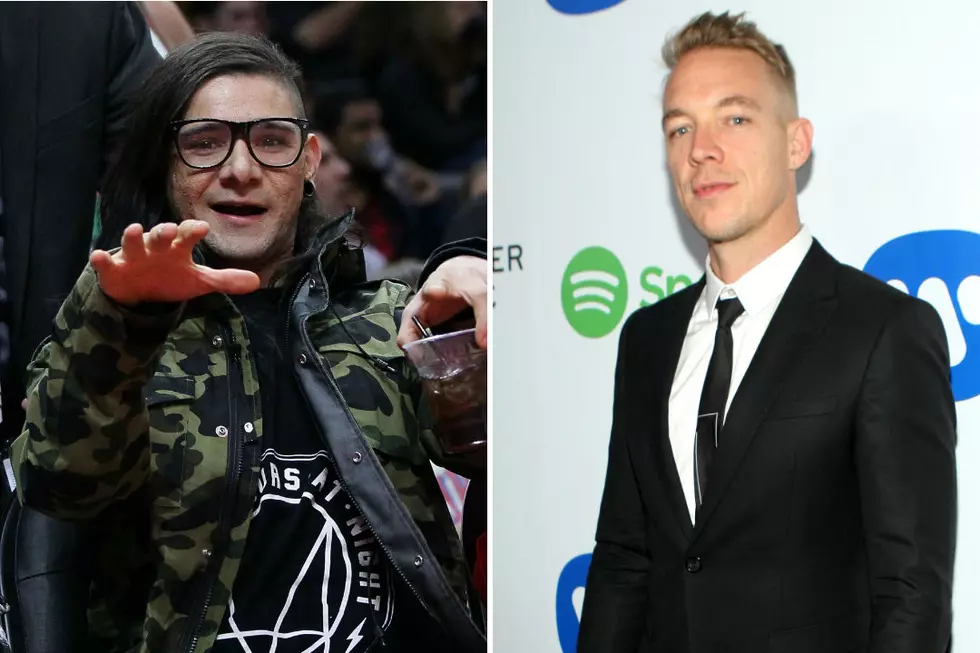
10 Years Ago: Skrillex Was Still Sonny Moore When From First to Last Released ‘Heroine’
From First to Last's second album, Heroine, was one of the last gasps of millennial post-hardcore and screamo. Released a decade ago today (March 21), the album also plays another, perhaps more pop-culturally significant role: It was the last album the band released with singer Sonny Moore, before he embarked on a successful solo career and became the EDM phenomenon known as Skrillex.
And if that isn’t enough trivia to get your juices flowing, consider this: When former FFTL bassist Jon Weisberg was let go in 2005 prior to the Heroine recording sessions, producer Ross Robinson (Korn, At the Drive-In) brought in Limp Bizkit guitarist Wes Borland to play bass on the album. Later that year, Borland even toured with the band. So essentially, you had a mashup between screamo kids, a nu-metal icon and the future king of American dubstep. Talk about worlds colliding.
Singer-guitarist Matt Good formed From First to Last in Florida in 1999 and, after releasing the Aesthetic EP in 2003 with Good and guitarist Travis Richter on vocals, Good used MySpace to enlist California-based singer Moore. Their 2004 debut, Dear Diary, My Teen Angst Has a Bodycount, thrust them to the forefront of the screamo movement.
While the follow-up, Heroine, was certainly a solid effort, the album is textbook screamo-by-numbers with some minor electronic flourishes that hint at what Moore would later embrace. What stands out the most, after all these years, is just how much Moore sounds like My Chemical Romance singer Gerard Way, who also used a similar visual aesthetic to Moore. Later in 2006 though, My Chem would push way past the envelope with their epic concept album The Black Parade, hammering one of the final nails in screamo’s mascara-tinged coffin.
Still, there’s plenty to like about Heroine – particularly the dense guitar work of Matt Good and Travis Richter. Throughout, there’s a strong element of jarring and chaotic noise, particularly in the numerous pummeling breakdowns on the album punctuated by Good’s frenetic fretwork. There’s clearly a darker, more turbulent sound on Heroine than what similar bands like My Chem and the Used were doing; the churning riffs and relentless rhythms are truly the hooks on the album, rather than any radio-friendly pop choruses. There’s just too much happening in the background to leave space for something as airy and simplistic as the Used’s “The Taste of Ink” or MCR's “I’m Not Okay (I Promise)."
Back in the day, fans responded nonetheless, snapping up 33,000 copies of Heroine in the first week and eventually vaulting the album to No. 25 on the Billboard 200. Major labels still desperately trying to latch onto the emo movement smelled blood in the water, and a bidding war ensued: By April, FFTL moved from indie Epitaph to major label Capitol Records, which most notably beat fellow suitor Warner Bros. in the race to enlist the band.
Critics were generally positive about Heroine, too. AbsolutePunk called it “gritty as hell" and "full of obscenities and soaring sing-along choruses" while Drowned in Sound praised the band's growth since their debut, noting that although “Sonny Moore's lyrics still leave much to be desired, he still portrays a real sense of emotion with his vocal style.”
But if 2006 was the beginning of the band's mainstream ascent, it also marked the end of their era with Moore. In early 2007, he left the band to begin his solo career. The band’s caustic, screamo style had torn his throat apart, leading to multiple corrective surgeries over the years. The remaining members of FFTL spent the remainder of that year scrambling to replace him before Good eventually took over lead vocals himself.
Moore, however, didn't morph into Skrillex overnight. There was a transitional period when Moore went only by the name "Sonny" and began to infuse more electronic elements into a sound still loosely rooted in rock. In 2008, he and a newly assembled band were among the opening acts on the AP Tour – but while headliners All Time Low and the Rocket Summer traveled on plush tour buses, Moore and his crew drove across the country in a van. The following year, he released the poorly received Gypsyhook EP, providing a snapshot of his burgeoning transformation.
When his new direction didn't resonate, Moore shifted his focus entirely to EDM culture and performed at Los Angeles clubs initially under the name "Twipz," then formally re-introduced himself with My Name Is Skrillex in 2010. He's arguably become the most recognizable face of EDM, with more Grammys (eight) than any other electronic artist ever. He's also among the genre's highest-paid performers, reportedly netting more than $16 million in 2014 alone. Clearly, his days touring in a van are far behind him.
Meanwhile, FFTL have struggled to maintain consistency – both with their sound and lineup. They released two more albums (From First to Last in 2008 and Throne to the Wolves in 2010) before a three-year hiatus. Last year, they released their fifth album, Dead Trees, with new vocalist Spencer Sotelo.
All of that makes celebrating the anniversary of Heroine much more complex than usual. While it remains an integral album in the screamo scene, it also heralded the genre's fast-approaching downward slide, while opening the door for Skrillex and dubstep to begin their eventual world domination.
The 100 Most Anticipated Albums of 2016
More From Diffuser.fm









